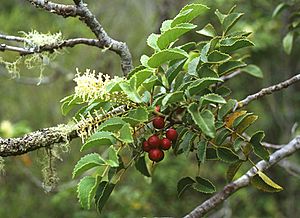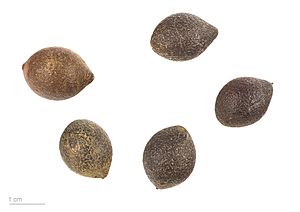Gevuina facts for kids
Quick facts for kids Gevuina |
|
|---|---|
 |
|
| Chilean hazel with flowers and fruits | |
| Scientific classification | |
| Genus: |
Gevuina
|
| Species: |
avellana
|
The Gevuina avellana is also known as the Chilean hazelnut. In Spanish, it's called avellano chileno. This tree is an evergreen, meaning it keeps its leaves all year round. It can grow up to 20 meters (about 65 feet) tall. It is the only species in its group, called the Gevuina genus.
This tree naturally grows in southern Chile and nearby valleys in Argentina. You can find it from sea level up to 700 meters (about 2300 feet) high. The leaves are bright green and have jagged edges. The tree blooms between July and November. Its flowers are tiny and light-colored, growing in long clusters. The fruit is a nut that starts dark red and turns black when it's ripe. The outside shell of the nut is hard and woody. The tree can grow straight up or branch out from the ground, looking like either a tall tree or a bushy shrub.
The name Gevuina comes from the Mapuche Indigenous word guevin. The Mapuche people are native to parts of Chile and Argentina. Spanish settlers called it avellano because its nuts looked like the hazelnuts they knew from Europe. However, the Chilean hazelnut is not closely related to European hazelnuts.
Contents
Where the Chilean Hazelnut Grows
It's hard to guess exactly where you'll find many Chilean hazelnut trees in a forest. They can grow on flat land or on hills. They don't mind if the soil is clay or rocky.
Usually, the Chilean hazelnut grows with other broad-leaved trees. Some of these trees include Nothofagus obliqua, Nothofagus dombeyi, and Laureliopsis. It can also grow with conifer trees like Austrocedrus and Fitzroya. This means you won't find forests made up only of Chilean hazelnut trees.
What Scientists Say About It
The Gevuina group of plants belongs to the Proteaceae family. Some scientists believe there are three species in the Gevuina group. One is found only in Australia (Gevuina bleasdalei). Another is found in New Guinea (Gevuina papuana). And the third is the Chilean hazelnut (Gevuina avellana).
However, other scientists think the Australian and New Guinea species should be in different groups. They place them in the Bleasdalea or Turrillia groups. If this is true, then Gevuina avellana would be the only species left in the Gevuina group. Most recent studies agree with this idea, placing the Australian and New Guinea species into the Bleasdalea group.
Uses and Growing the Tree
The nuts of the Chilean hazelnut are quite useful! People eat them raw, boil them, or toast them. These nuts are healthy, containing about 12 percent protein, 49 percent oil, and 24 percent carbohydrates. The oil from the nuts is very rich in healthy fats, especially monounsaturated oils. It also has many antioxidants, like vitamin E and beta-carotene.
This special oil is used in many ways. It's an ingredient in some sunscreens. It's also used in cosmetics because it helps moisturize skin and contains omega 7 fatty acids. The amount of nuts a tree produces can be very different from one tree to another.
The Chilean hazelnut tree is also good for bees, as it provides them with honey. People also grow it as an ornamental plant because it looks nice. The shells of the nuts contain a substance called tannin, which is used to make leather.
This tree can handle cold weather pretty well. A grown tree can survive temperatures as low as −12 °C (10 °F). The wood of the tree is light-colored with dark brown streaks. It's used to make furniture and musical instruments.
The Chilean hazelnut tree was brought to Great Britain in 1826. It grows well there, as well as in Ireland, New Zealand, and California. A few trees are also grown in Spain and the Pacific Northwest of the United States. It thrives in places with mild ocean climates where winters are cool and frosts are common. In southern New Zealand, it has grown very well.
It takes about 5 years for a tree to produce its first nuts. It takes 7 or 8 years for the tree to produce a full harvest. In Seattle, Washington, squirrels and birds enjoy eating the seeds from these trees. Scientists in Chile and New Zealand are working to create new types of Chilean hazelnut trees that produce even more nuts than the wild ones.
In 1982, only a small part of the wild nuts were collected and processed.
Gallery
See also
 In Spanish: Avellano para niños
In Spanish: Avellano para niños






